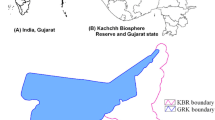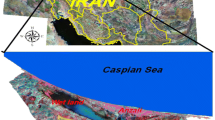Abstract
An extensive riverine wetlands system, which includes two Ramsar sites, occurs in the interfluvial zone between the Ganga and Sai Rivers in the Gangetic plains. Channel avulsion has formed a system of sinuous channel wetlands and floodplain wetlands, such as oxbow lakes, meanders, complex scrolls, and the remnant of fluvial features that grew through erosional and depositional processes, resulting in riverine wetlands. These riverine wetlands are significant but endangered and threatened biodiversity hotspots. The study of spatial distribution and temporal change analysis of these riverine wetlands are very much necessary for assessment and management. Extraction, delineation and mapping of these riverine wetlands in the GIS environment using remote sensing data reveal that these riverine wetlands belong to an unstable fluvial system with low energy and high sediment yield. The spatio-temporal changes in the areal extent of these riverine wetlands have been assessed by an image-to-image change detection method based on spectral indices (NDVI and MNDWI) derived from satellite imagery from 2000 to 2019. The analysis showed that the floodplain wetlands are shrinking continuously, whereas the channel wetlands shrank up to 2014 and afterwards increased gradually due to rejuvenation activities; however, the overall trend is still decreasing with respect to the year 2000. Drought conditions prevail frequently, and extreme stress due to land use and land cover changes, along with the groundwater exploitation, will likely lead to continued declines in these unstable, low-energy riverine wetlands in the near future, which will ecologically and environmentally affect the interfluvial zone of the Ganga and Sai Rivers.


(Source: USGS)









Similar content being viewed by others
Data Availability
All data produced from this study are provided in this manuscript. The datasets generated during and/or analysed during the current study are available from the corresponding author on reasonable request.
References
Acreman M, Holden J (2013) How wetlands affect floods. Wetlands 33(5):773–786. https://doi.org/10.1007/s13157-13013-10473-13152
Athira K, Singh S, Abebe A (2022) Impact of individual and combined influence of large-scale climatic oscillations on Indian summer monsoon rainfall extremes. Clim Dyn 1–25. https://doi.org/10.1007/s00382-00022-06477-w
Central Pollution Control Board (CPCB) (2008) Status of Water Quality in India 2007. Central Pollution Control Board. Ministry Ministry of Environment and Forests, Government of India, New Delhi
Costanza R, d’Arge R, De Groot R, Farber S, Grasso M, Hannon B, Limburg K, Naeem S, O’neill RV, Paruelo JJN (1997) The value of the world’s ecosystem services and natural capital. Nature 387(6630):253–260
Cowardin LM (1979) Classification of wetlands and deepwater habitats of the United States, Fish and Wildlife Service, US Department of the Interior
Crippen R (1990) Calculating the vegetation index faster. Remote Sensing of Environment 34(1):71–73. https://doi.org/10.1016/0034-4257(1090)90085-Z
Dai X, Yang G, Wan R, Li Y (2018) The effect of the Changjiang River on water regimes of its tributary Lake East Dongting. Journal of Geographical Sciences 28(8):1072–1084. https://doi.org/10.1007/s11442-11018-11542-11445
Davis JA, Froend RJWE (1999) Loss and degradation of wetlands in southwestern Australia: underlying causes, consequences and solutions. Wetlands Ecology Management 7(1):13–23. https://doi.org/10.1023/A:1008400404021
De Wilde M, Puijalon S, Vallier F, Bornette G (2015) Physico-chemical consequences of water-level decreases in wetlands. Wetlands 35(4):683–694. https://doi.org/10.1007/s13157-13015-10658-y
Dixit K (2016) Villagers rebuild mud bund on Bakulahi river. TNN/TOI, http://timesofindia.indiatimes.com/articleshow/53626541.cms?utm_source=contentofinterest&utm_medium=text&utm_campaign=cppst
Eid ANM, Olatubara C, Ewemoje T, Farouk H, El-Hennawy MT (2020) Coastal wetland vegetation features and digital Change Detection Mapping based on remotely sensed imagery: El-Burullus Lake, Egypt. International Soil and Water Conservation Research 8(1):66–79
Fisher A, Flood N, Danaher T (2016) Comparing Landsat water index methods for automated water classification in eastern Australia. Remote Sensing of Environment 175:167–182. https://doi.org/10.1016/j.rse.2015.1012.1055
Han-Qiu X (2005) A study on information extraction of water body with the modified normalised difference water index (MNDWI). Journal of remote sensing 9(5):589–595. 2.976
Hu S, Niu Z, Chen Y, Li L, Zhang H (2017) Global wetlands: Potential distribution, wetland loss, and status. Sci Total Environ 586:319–327. https://doi.org/10.1016/j.scitotenv.2017.1002.1001
Komuscu UA (1999) Using the SPI to analyse spatial and temporal patterns of drought in Turkey. Drought Network News (1994-2001), 49
Krishnan MS (1960) Geology of India and Burma
Kumar S, Singh I, Singh M, Singh D (1995) Depositional pattern in upland surfaces of Central Gangetic Plain near Lucknow. Geological Society of India 46:545–556
Lemly AD, Kingsford RT, Thompson JR (2000) Irrigated agriculture and wildlife conservation: conflict on a global scale. Environ Manage 25:485–512. https://doi.org/10.1007/s002679910039
Lessels JS, Tetzlaff D, Birkel C, Dick J, Soulsby C (2016) Water sources and mixing in riparian wetlands revealed by tracers and geospatial analysis. Water Resour Res 52(1):456–470. https://doi.org/10.1002/2015WR017519
Liu G, Zhang L, Zhang Q, Musyimi Z, Jiang Q (2014) Spatio–temporal dynamics of wetland landscape patterns based on remote sensing in Yellow River Delta, China. Wetlands 34(4):787–801. https://doi.org/10.1007/s13157-13014-10542-13151
Liu H, Deng B, Liu Y, Jiang C, Wu Z, Long Y (2018) Preliminary numerical analysis of the efficiency of a central lake reservoir in enhancing the flood and drought resistance of Dongting Lake. Water 10(2):225. https://doi.org/10.3390/w10020225
Malik A, Brönnimann S (2018) Factors affecting the inter-annual to centennial timescale variability of Indian summer monsoon rainfall. Climate Dynamics 50(11):4347–4364. https://doi.org/10.1007/s00382-00017-03879-00383
Matthews GVT (1993) The Ramsar Convention on Wetlands: its history and development, Ramsar Convention Bureau, Gland, Switzerland
McFeeters SK (1996) The use of the Normalised Difference Water Index (NDWI) in the delineation of open water features. International Journal of Remote Sensing 17(7):1425–1432. https://doi.org/10.1080/01431169608948714
McKee TB, Doesken NJ, Kleist J (1993) The relationship of drought frequency and duration to time scales. In Proceedings of the 8th Conference on Applied Climatology (Vol. 17, No. 22, pp. 179–183)
Misra AK (2011) Impact of urbanisation on the hydrology of Ganga Basin (India). Water Resources Management 25(2):705–719. https://doi.org/10.1007/s11269-11010-19722-11269
Mitsch WJ, Gosselink JG (2000) The value of wetlands: the importance of scale and landscape setting. Ecological Economics 35(1):25–33. https://doi.org/10.1016/S0921-8009(1000)00165-00168
Mitsch WJ, Hernandez ME (2013) Landscape and climate change threats to wetlands of North and Central America. Aquatic Sciences 75(1):133–149. https://doi.org/10.1007/s00027-00012-00262-00027
Mukherjee K, Pal S (2021) Hydrological and landscape dynamics of floodplain wetlands of the Diara region, Eastern India. Ecological indicators 121:106961. https://doi.org/10.1016/j.ecolind.102020.106961.
Namaalwa S, Funk A, Ajie G, Kaggwa R (2013) A characterisation of the drivers, pressures, ecosystem functions and services of Namatala wetland, Uganda. Environmental Science & Policy 34:44–57. https://doi.org/10.1016/j.envsci.2013.1001.1002
Ortmann-Ajkai A, Csicsek G, Hollós R, Magyaros V, Wágner L, Lóczy D (2018) Twenty-years’ changes of wetland vegetation: effects of floodplain-level threats. Wetlands 38(3):591–604. https://doi.org/10.1007/s13157-13018-11002-13150
Ozelkan E (2020) Water body detection analysis using NDWI indices derived from landsat-8 OLI. Polish Journal of Environmental Studies 29(2):1759–1769. https://doi.org/10.15244/pjoes/110447
Paul S, Pal S (2020) Exploring wetland transformations in moribund deltaic parts of India. Geocarto International 35(16):1873–1894. https://doi.org/10.1080/10106049.10102019.11581270
Pettorelli N (2013) The normalised difference vegetation index. Oxford University Press
Prigent C, Papa F, Aires F, Jimenez C, Rossow W, Matthews E (2012) Changes in land surface water dynamics since the 1990s and relation to population pressure. Geophysical Research Letters 39(8):L08403. https://doi.org/10.01029/02012GL051276
Rao M (1973) The subsurface geology of the Indo-Gangetic plains. 14(3):217–242
Russell MT, Cartwright JM, Collins GH, Long RA, Eitel JH (2020) Legacy effects of hydrologic alteration in playa wetland responses to droughts. Wetlands 40(6):2011–2024. https://doi.org/10.1007/s13157-13020-01334-13150
Sarkar UK, Borah BC (2018) Flood plain wetland fisheries of India: with special reference to impact of climate change. Wetlands Ecology 26(1):1–15. https://doi.org/10.1007/s11273-11017-19559-11276
Schneider C, Flörke M, De Stefano L, Petersen-Perlman JD (2017) Hydrological threats to riparian wetlands of international importance–a global quantitative and qualitative analysis. Hydrology Earth System Sciences 21(6):2799–2815. https://doi.org/10.5194/hess-2721-2799-2017
Secretariat R (2013) The list of wetlands of international importance. The Secretariat of the Convention on Wetlands, Gland
Shukla SS, Mishra M (2019) Tracing of palaeochannels of Bakulahi river system in Uttar Pradesh, India. Arabian Journal of Geosciences 12(9):1–9. https://doi.org/10.1007/s12517-12019-14429-12516
Singh IB (1996) Geological evolution of Ganga Plain—an overview. J Palaeontol Soc India 41:99–137
Singh M, Sinha R (2019) Evaluating dynamic hydrological connectivity of a floodplain wetland in North Bihar, India using geostatistical methods. Science of the Total Environment 651:2473–2488. https://doi.org/10.1016/j.scitotenv.2018.2410.2139
Singh IB, Srivastava P, Sharma S, Sharma M, Singh DS, Rajagopalan G, Shukla UK (1999) Upland interfluve (Doab) deposition: alternative model to muddy overbank deposits. Facies 40(1):197–210. https://doi.org/10.1007/BF02537474
Singh S, Parkash B, Rao MS, Arora M, Bhosle B (2006) Geomorphology, pedology and sedimentology of the Deoha/Ganga–Ghaghara Interfluve, Upper Gangetic Plains (Himalayan foreland basin)—extensional tectonic implications. CATENA 67(3):183–203. https://doi.org/10.1016/j.catena.2006.1003.1013
Singh, A. and R. Sinha (2019a) Fluvial response to climate change inferred from sediment cores from the Ghaggar–Hakra paleochannel in NW Indo–Gangetic plains. Palaeogeography, Palaeoclimatology, Palaeoecology 532:109247. https://doi.org/10.1016/j.palaeo.102019.109247.
Singh M, Sinha R (2020) Distribution, diversity, and geomorphic evolution of floodplain wetlands and wetland complexes in the Ganga plains of north Bihar, India. Geomorphology 351:106960. 1069. https://doi.org/10.1016/j.geomorph.102019.106960.
Sinha R, Saxena S, Singh M (2017) Protocols for riverine wetland mapping and classification using remote sensing and GIS. Current Science 1544–1552
Srivastava P, Singh I, Sharma M, Singhvi A (2003) Luminescence chronometry and Late Quaternary geomorphic history of the Ganga Plain, India. Palaeogeogr Palaeoclimatol Palaeoecol 197(1–2):15–41. https://doi.org/10.1016/S0031-0182(1003)00384-00385
Suir GM, Sasser CE (2019) Use of NDVI and landscape metrics to assess effects of riverine inputs on wetland productivity and stability. Wetlands 39(4):815–830. https://doi.org/10.1007/s13157-13019-01132-13153
Szabo S, Gacsi Z, Balazs B (2016) Specific features of NDVI, NDWI and MNDWI as reflected in land cover categories. Landscape & Environment 10(3–4):194–202. https://doi.org/10.21120/LE/21110/21123-21124/21113
Taddeo S, Dronova I, Depsky N (2019) Spectral vegetation indices of wetland greenness: Responses to vegetation structure, composition, and spatial distribution. Remote Sens Environ 234:111467
Thomas H, Nisbet T (2007) An assessment of the impact of floodplain woodland on flood flows. Water Environ J 21(2):114–126. https://doi.org/10.1111/j.1747-6593.2006.00056.x
Waltham NJ, Burrows D, Wegscheidl C, Buelow C, Ronan M, Connolly N, Groves P, Marie-Audas D, Creighton C, Sheaves M (2019) Lost floodplain wetland environments and efforts to restore connectivity, habitat, and water quality settings on the Great Barrier Reef. Front Mar Sci 6:71. https://doi.org/10.3389/fmars.2019.00071
Wang Y, Molinos JG, Shi L, Zhang M, Wu Z, Zhang H, Xu J (2019) Drivers and changes of the Poyang Lake wetland ecosystem. Wetlands 39(1):35–44. https://doi.org/10.1007/s13157-13019-01180-13159
Wantzen KM, Yule CM, Tockner K, Junk WJ (2008) Riparian wetlands of tropical streams. Tropical Stream Ecology, Elsevier 199–217. https://doi.org/10.1016/B1978-012088449-012088440.012050009-012088441
Zhao Z, Liu L, Wang Z, Zhang Y, Li L, Liu F (2020) Dynamic Changes of Plateau Wetlands in the Damqu River Basin, Yangtze River Source Region, China, 1988–2015. Wetlands 40(5):1409–1424. https://doi.org/10.1007/s13157-13020-01271-y
Acknowledgements
The authors are highly grateful to the Department of Civil Engineering, Indian Institute of Technology (BHU), for providing facilities for this study. The authors express thanks to the University Grants Commission (UGC), New Delhi, India, for financial assistance.
Author information
Authors and Affiliations
Contributions
All authors contributed to the study’s conception and design. Material preparation, data collection and analysis were performed by Sandeep Kumar Maddheshiya and Nikhilesh Singh. Prof. Sanjay Tignath, Dr Medha Jha and Sandeep Kumar Maddheshiya have made the data interpretation. The first draft of the manuscript was written by Sandeep Kumar Maddheshiya. All authors commented on previous versions of the manuscript. All authors read and approved the final manuscript.
Corresponding author
Ethics declarations
Conflicts of Interest
The authors declare that they have no potential conflicts of interest in terms of their personal or financial interests.
Additional information
Publisher's Note
Springer Nature remains neutral with regard to jurisdictional claims in published maps and institutional affiliations.
Rights and permissions
Springer Nature or its licensor (e.g. a society or other partner) holds exclusive rights to this article under a publishing agreement with the author(s) or other rightsholder(s); author self-archiving of the accepted manuscript version of this article is solely governed by the terms of such publishing agreement and applicable law.
About this article
Cite this article
Maddheshiya, S.K., Jha, M., Tignath, S. et al. Hydrogeomorphic and Spatio-Temporal Analysis of Riverine Wetlands in the Interfluvial Zone of Ganga and Sai Rivers, Uttar Pradesh, India. Wetlands 43, 9 (2023). https://doi.org/10.1007/s13157-022-01654-3
Received:
Accepted:
Published:
DOI: https://doi.org/10.1007/s13157-022-01654-3




